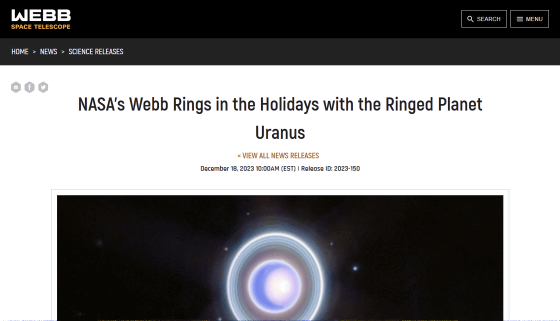NASA releases new image of the beautifully shining ``Rings of Uranus'' taken with the James Webb Space Telescope

Uranus, the seventh
NASA's Webb Rings in the Holidays with the Ringed Planet Uranus | Webb
https://webtelescope.org/contents/news-releases/2023/news-2023-150

The rings of Uranus look positively festive in epic James Webb Space Telescope holiday photo | Space
https://www.space.com/uranus-rings-james-webb-space-telescope-holiday-photo
Webb telescope's new portrait showcases Uranus' mysterious features | CNN
https://edition.cnn.com/2023/12/19/world/webb-uranus-rings-polar-cap-scn/index.html
Uranus is a rare planet whose equatorial plane has an angle (equatorial inclination) of 98 degrees with respect to its orbit around the sun, and it revolves on its side facing the sun. The Earth's equatorial tilt angle is 23.4 degrees, meaning that the Earth revolves at a slight angle toward the sun. Furthermore, since Uranus's orbital period is 84 years, day and night last for 42 years each at the two polar caps , which correspond to Earth's north and south poles.
It is also known that Uranus has rings like Saturn and Jupiter, and because its axis of rotation is tilted sideways, the rings of Uranus face straight toward the sun on the summer or winter solstice. This is a phenomenon unique to Uranus and not seen on Saturn or Jupiter.
Since Uranus will reach the summer solstice in 2028, the rings of Uranus are almost straight toward the sun even at the time of writing the article, and from the Earth near the sun, the rings of Uranus appear to be facing us. Therefore, in April 2023, NASA photographed Uranus' rings with the near-infrared camera of the James Webb Space Telescope. The image taken in April is shown below using two filters, 1.4 micron and 3.0 micron, and is displayed in two-tone blue and orange colors.

In December 2023, NASA released a more detailed image of Uranus taken by the James Webb Space Telescope with new wavelengths of 2.1 microns and 4.6 microns.
Below is the latest image of Uranus, where you can see the dark outer and inner parts of Uranus's multiple rings, as well as the small, dark satellites that overlap the rings. You can also see that the fuzzy polar caps of the gas planet Uranus become darker as you move to lower latitudes, and that storms appear as bright white dots.

In the image with a wider field of view, we could also see the major moons shining blue, distant from Uranus.

'The James Webb Space Telescope's unparalleled infrared resolution and sensitivity now allows astronomers to see Uranus and its unique features with breakthrough clarity,' NASA said in a statement. , especially the details of the Zeta ring near Uranus, are of great importance in planning future missions to Uranus. It also serves as a proxy for research: this ``exoplanet in your backyard'' will help astronomers understand how a planet of this size functions, what its climate is like, and how it formed. 'By placing the solar system in a larger context, studying Uranus can also help us understand the solar system as a whole.'
Related Posts:
in Science, Posted by log1h_ik







